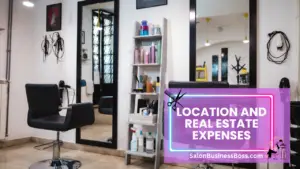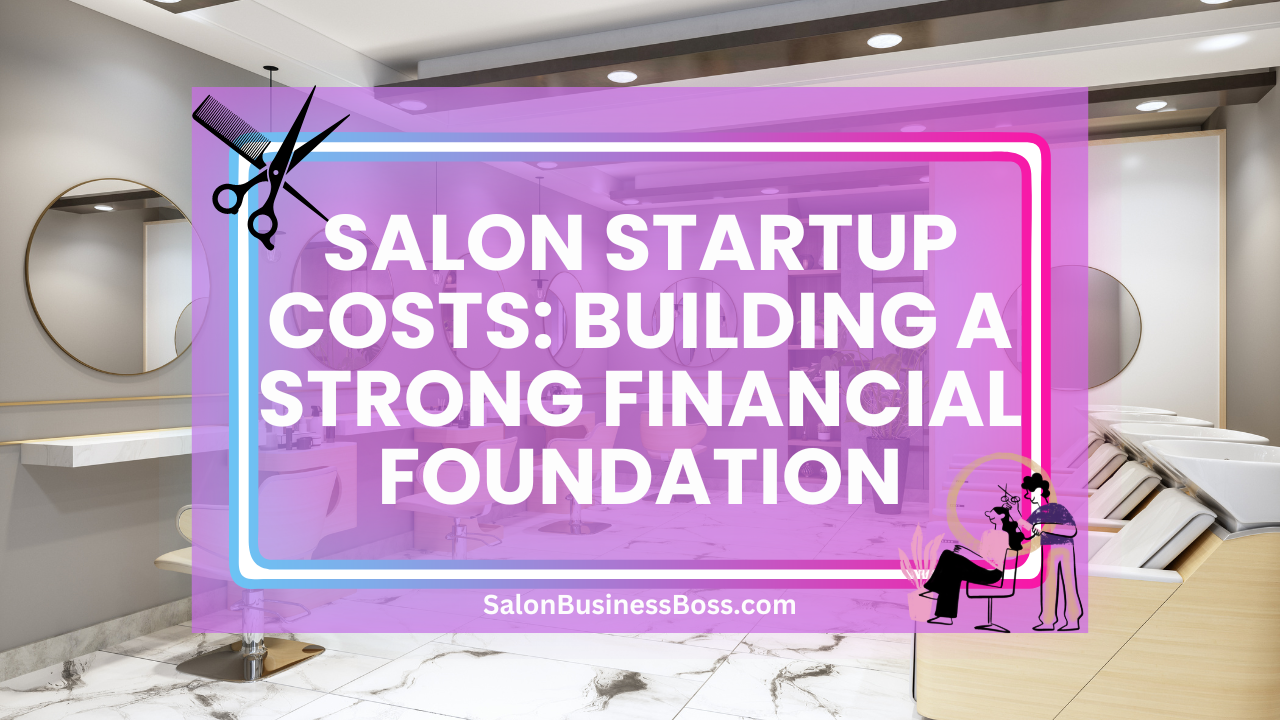Starting a salon can be a dream come true for aspiring entrepreneurs in the beauty industry. However, before embarking on this exciting venture, it is essential to understand the various costs involved. In this article, we will delve into the detailed breakdown of these startup costs to provide an understanding of the financial aspects of launching a salon business.
Salon startup costs can vary from $100,000 to $500,000. The major expenses include real estate, equipment, inventory, licensing, marketing, and staff salaries. Proper budgeting is vital for a successful salon venture.
1. Location and Real Estate Expenses

Securing the ideal location is undeniably one of the most critical and costly aspects when embarking on the journey of starting a salon. The significance of the location lies in its potential to attract a steady stream of clients, foster brand visibility, and ultimately contribute to the salon’s overall success.
The cost of real estate can fluctuate significantly based on several factors, with size, location, and local market conditions playing pivotal roles. Urban areas and high-traffic regions, known for their bustling activity, tend to command higher rental rates compared to more tranquil suburban or rural locations. Salon owners must carefully consider their target demographic and business goals when selecting the ideal location.
Budgeting for rent is a key aspect of financial planning during the startup phase. Salon owners should be prepared to allocate between $2,000 to $15,000 per month for rent, depending on the chosen location and its proximity to potential clients. Larger spaces, prime locations, and areas with higher demand for salon services typically come with heftier price tags.
Investing in the right location can lead to a competitive edge, as it allows for increased foot traffic and exposure to potential customers. The right location can facilitate word-of-mouth marketing and build a loyal customer base, enhancing the salon’s long-term prospects for growth and profitability. Therefore, careful consideration, market research, and financial prudence are crucial in securing the perfect location for a successful salon venture.
Read more about: From Vision to Reality: Evaluating Your Salon Setup Cost Estimates
2. Salon Equipment and Furniture
In the competitive world of the beauty industry, a well-equipped salon is the backbone of delivering top-notch services and a remarkable customer experience. Salon equipment and furniture are integral components of setting up a successful business that caters to the diverse needs of clients. Startup costs for these essentials can vary, typically falling within the range of $20,000 to $50,000.
The list of salon equipment is extensive, encompassing crucial items that are indispensable for daily operations. Salon chairs, designed for comfort and functionality, play a significant role in providing clients with a relaxing experience during their appointments. Styling stations, equipped with storage and utilities, enable stylists to efficiently perform their services while keeping everything organized.
Washbasins, another essential item, allow clients to indulge in a luxurious hair wash experience. High-quality hair dryers ensure efficient and gentle hair drying without compromising the clients’ comfort. Mirrors are an integral part of any salon, providing clients with the opportunity to see the transformations unfold before their eyes.
A well-designed reception area with a stylish reception desk enhances the overall ambiance and sets the tone for a professional and welcoming salon environment. Investing in durable and high-quality equipment is essential for ensuring long-term cost-effectiveness and reducing maintenance and replacement expenses.
Equipping the salon with the right tools not only enhances the customer experience but also improves the productivity and efficiency of the salon staff. Happy and satisfied clients are more likely to become loyal patrons, spreading positive word-of-mouth and contributing to the salon’s growth and success. By prioritizing the acquisition of top-notch equipment, salon owners can lay the foundation for a thriving business that stands out in the competitive market.
3. Inventory and Supplies
Stocking up on high-quality beauty products and supplies is a crucial step for any salon startup, as it directly impacts the quality of services offered and the overall customer experience. The cost of inventory can vary depending on various factors, including the salon’s size, specialization, and the brands selected for use. Consequently, salon owners should plan and budget wisely to strike a balance between offering a diverse selection of products and managing startup costs effectively.
The range of services provided by the salon is a significant determinant of the required inventory. Different services, such as haircare, skincare, and nail treatments, demand specific products and tools to cater to various client needs. Moreover, the number of products available can influence the breadth and depth of the salon’s offerings, appealing to a wider clientele.
The selection of brands is equally crucial, as it can impact both the salon’s reputation and the cost of inventory. Premium brands often come with higher price tags, while lesser-known or generic options might be more budget-friendly. Striking the right balance between quality and affordability is essential to meet clients’ expectations while managing expenses.
A prudent budget for the initial inventory typically ranges from $5,000 to $20,000. This investment ensures the salon has a well-rounded collection of haircare products, styling tools, skincare items, and other beauty essentials to kickstart operations effectively. Regularly assessing inventory needs, monitoring product usage, and anticipating demand can help salon owners optimize their inventory management for long-term success.
Investing in a diverse and high-quality inventory is a strategic move that can lead to customer satisfaction, positive word-of-mouth, and repeated business. A well-stocked salon instills confidence in clients, fostering a loyal customer base that contributes significantly to the salon’s growth and prosperity over time.
4. Licensing, Permits, and Legal Fees
Compliance with local regulations and acquiring the required licenses and permits is a pivotal phase in the establishment of a salon business. Ensuring legal compliance not only protects the salon from potential penalties and liabilities but also reflects the professionalism and credibility of the salon to clients and stakeholders.
The cost of licensing and legal fees can fluctuate significantly depending on the state or municipality where the salon is located ranging from $500 to $5,000 or more. Different regions may have specific requirements and fees associated with operating a salon. It is crucial for salon owners to thoroughly research and understand the local regulatory landscape to accurately estimate these costs.
Licensing fees typically cover various aspects, such as health permits, business permits, and cosmetology licenses, which are essential for conducting salon services legally. Moreover, compliance with health and safety regulations is vital to guarantee a safe and hygienic environment for clients and employees alike.
Salon owners should factor in legal consultation fees to ensure that their startup process is smooth and free from legal complications. Seeking advice from legal experts specializing in business regulations and the beauty industry can help navigate potential legal pitfalls and ensure full compliance with all relevant laws.
By investing in proper licensing and legal processes, salon owners demonstrate their commitment to ethical business practices, client safety, and the well-being of their employees. This level of professionalism builds trust and confidence among clients, helping the salon establish a positive reputation in the industry. Ultimately, compliance with local regulations and licensing requirements lays the foundation for a successful salon venture that operates within the bounds of the law and delivers exceptional services.
5. Salon Software and Technology

In today’s digital age, the integration of salon management software and technology has become a prerequisite for smooth and efficient salon operations. Embracing technology not only streamlines internal processes but also enhances customer service, making it a valuable asset for any salon business.
Salon software offers a plethora of features designed to optimize daily tasks and boost productivity. One of the most significant advantages is the simplified appointment scheduling system. Clients can book appointments online, eliminating the need for manual booking and reducing the likelihood of scheduling conflicts. Automating this process ensures that salon staff can allocate their time more efficiently, leading to a seamless and organized workflow.
Salon software facilitates inventory management, which is crucial for maintaining an up-to-date product stock and avoiding overstocking or shortages. By monitoring product levels, salon owners can optimize inventory purchasing, minimizing waste and maximizing profitability.
Customer relationship management (CRM) is another invaluable aspect of salon software. It allows salons to store customer information, track their preferences, and manage loyalty programs effectively. Personalized customer interactions not only strengthen customer loyalty but also contribute to increased customer retention and positive word-of-mouth referrals.
The cost of salon software can vary depending on the software’s complexity and the range of features offered. Typically, salon owners should budget between $1,000 to $5,000 for implementing a robust and comprehensive salon management system. While the initial investment may seem significant, the long-term benefits of improved efficiency, enhanced customer experience, and streamlined operations make it a worthwhile investment.
Read more about: Salon Floor Plan Design: Creating an Inviting and Functional Space
6. Marketing and Advertising
In the bustling and competitive beauty industry, attracting a steady stream of clients requires a well-thought-out marketing and advertising strategy. Salon owners must allocate a reasonable budget for initial marketing efforts to ensure their salon gains visibility and reaches their target audience effectively.
An allocated budget of $5,000 to $20,000 is a prudent investment in marketing, as it allows for a comprehensive approach that encompasses various channels. Social media marketing is an integral part of modern promotional campaigns, given the widespread use of platforms like Facebook, Instagram, and Twitter. Engaging content, eye-catching visuals, and timely responses to customer inquiries on social media can drive brand awareness and foster a loyal online community.
Online advertising, such as pay-per-click (PPC) campaigns and display ads, can expand the salon’s reach and attract potential clients actively searching for beauty services. This digital advertising approach ensures that the salon appears prominently in relevant search results and on websites frequented by the target demographic.
Print materials, such as flyers, brochures, and business cards, remain effective tools for local marketing and networking. Distributing these materials strategically in the salon’s vicinity can pique the interest of potential clients and generate word-of-mouth referrals.
Promotional events and special offers can create a buzz around the salon and incentivize potential clients to give their services a try. Hosting launch parties, offering first-time client discounts, or bundling services can entice new customers and encourage repeat visits.
The significance of effective marketing and advertising campaigns cannot be underestimated in attracting and retaining clients. By thoughtfully allocating a budget to diverse marketing strategies, salon owners can elevate their brand presence, build a loyal customer base, and achieve long-term success in the competitive beauty market.
7. Staff Salaries and Training
The success of a salon hinges on the expertise and dedication of its staff. Budgeting for employee salaries is a pivotal aspect of financial planning for any salon startup. The costs associated with staff salaries can fluctuate widely, depending on various factors such as the salon’s size, location, and compensation structure ranging from $30,000 to $100,000 per year or more.
Key staff members in a salon include hairstylists, estheticians, receptionists, and assistants, each playing a crucial role in delivering exceptional customer experiences. Their salaries are often based on experience, expertise, and the salon’s overall compensation philosophy.
In urban areas with a higher cost of living and increased competition for talent, staff salaries may lean towards the higher end of the scale. On the other hand, in smaller towns or rural locations, salaries may be relatively lower.
Investing in staff training and development is equally vital for sustaining a high level of expertise and ensuring customer satisfaction. Ongoing training allows staff to stay updated with the latest trends, techniques, and product knowledge, enhancing the quality of services offered. It also instills a sense of professionalism and commitment among the team, reflecting positively on the salon’s reputation.
Offering benefits and incentives can attract and retain top talent. Health insurance, retirement plans, and performance-based bonuses are examples of perks that can motivate employees to excel in their roles and contribute to the salon’s success.
Conclusion
Launching a successful salon business requires careful planning and financial considerations. The startup costs, which can range from $100,000 to $500,000, encompass various aspects, including real estate expenses, equipment and furniture, inventory and supplies, licensing and legal fees, technology, marketing, staff salaries, insurance, and interior design. By understanding and budgeting for these expenses, aspiring salon owners can embark on their entrepreneurial journey with confidence and set the stage for a thriving and prosperous salon business.
Frequently Asked Questions

1. Are there ongoing costs beyond the initial startup expenses?
Yes, ongoing costs include rent, inventory replenishment, employee salaries, marketing, utilities, and maintenance.
2. How long does it take for a salon to become profitable?
The time to profitability varies, but with proper planning and execution, a salon can become profitable within a year or two.
3. Can I get financial assistance for salon startup costs?
Yes, you can explore small business loans, grants, or partnerships to help with funding the startup costs of your salon.
To learn more on how to start you own salon checkout my startup documents here.
Please note that the contents of this blog are for informational and entertainment purposes only and should not be construed as legal advice. Any action taken based on the information provided in this blog is solely at your own risk. Additionally, all images used in this blog are generated under the CC0 license of Creative Commons, which means they are free to use for any purpose without attribution.

About the author. Entrepreneur and Salon Business Fan.
Hi! I am Shawn and I am a happy individual who happens to be an entrepreneur. I have owned several types of businesses in my life from a coffee shop to an import and export business to an online review business plus a few more and now I create online salon business resources for those interested in starting new ventures. It’s demanding work but I love it. I do it for those passionate about their business and their goals. That’s why when I meet a salon business owner, I see myself. I know how hard the struggle is to retain clients, find good employees and keep the business growing all while trying to stay competitive.
That’s why I created Salon Business Boss: I want to help salon business owners like you build a thriving business that brings you endless joy and supports your ideal lifestyle.


